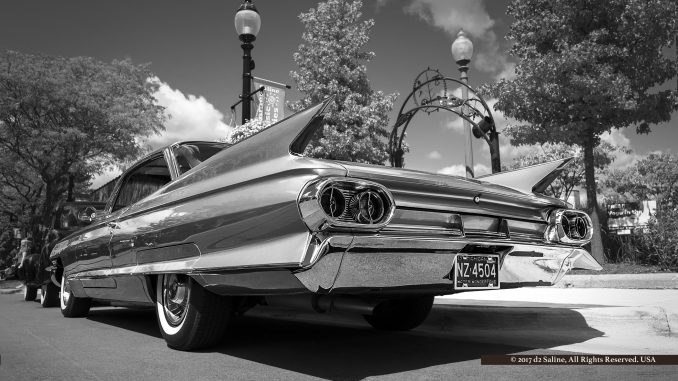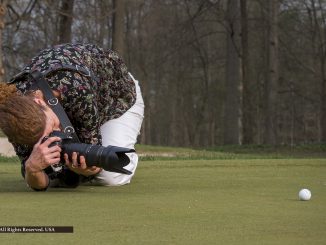
The image above was originally captured from ground level, camera and photographer positioned near the center line of North Ann Arbor Street in downtown Saline, on a Saturday.
This was last weekend and not just any Saturday, of course. It was during the afternoon of Saline’s Summerfest. And the thoroughfare was blocked off for the 35th annual Saline Street Machines car show. As always: Safety first. [1,2]
There are a number of considerations that make this photograph a helpful study. Unique attributes of the main subject, a 1961 Cadillac Coupe de Ville. Lighting. Overall environment and what from that could be included, excluded, and how, for context. Last but not least, the camera itself, with fixed focal length 28mm lens. [3,4,5,6]
Exotic tailfins on any period Cadillac often define the vehicle. So much so that they will often effortlessly command attention from the most hurried pedestrian passing within view. But the photographer should pause before clicking to ask if a consequent image from a camera at eye- or waist-level is optimal. [7,8,9,10]
Fantastic as this car looks in color — that’s how it was originally recorded — the scene cried out for processing as monochrome. So add that to the list of technical needs to be served. [11]
By pure coincidence, this Cadillac was parked behind a black 1939 Oldmobile Series 60. In this case, that allowed for the inclusion of a second car without distraction. It’s just enough present to help make it harder to tell when this photograph was taken if you’re not familiar with Saline.
Further attention to background details led to tweaking composition horizontally for placement of the driver side tailfin in front of a tree, keeping the “Saline Summer Music Series” banner, and omitting the blue portable restroom on the sidewalk.
Mid-day sun worked well with Coupe de Ville lines, then dropping an inky shadow that kept underbody car appointments from making too much of a show. But the chrome in that same sun was as much enemy as friend: Camera placement was critical by inches and degrees in order to control offending specular highlights.
Working with a full-frame camera and prime 28mm lens created desirable barrel distortion that further brings viewer attention to the closer tailfin but doesn’t distractingly keystone the street lights. Very good walking-around, street photography focal length. The 28mm equivalent for APS-C sensors is 18.3mm, and the Ricoh GR II is a top pick for this. (See reviews online.) [12,13,14,15]
Finally, this angle puts front-and-center the signature 1961 introduction of lower-body secondary fins. [16]
Dave Holls, who was assistant chief designer at Cadillac at the time, credited his then-boss, Chuck Jordan, for the lower fins (or ‘skegs,’ a nautical word referring to the extension of a boat’s keel leading to its centrally mounted rudder). According to Holls, the design team initially meant for the skegs to be the dominant fins, but was overruled by GM’s styling boss, Harley Earl.
Projecting from the car at a 45-degree angle, the skegs would catch the light, nearly giving the lower half of the body a two-tone effect. They also contributed to the car’s apparent length, with their strong repetition of the body-length horizontal character line and the flat line of the fins. This was a welcome benefit in 1961, when the cars were actually three inches shorter than the preceding year’s.
It would seem then that the ubiquitous smartphone can add value to car photographs through more than just improving camera technology. Before tripping the shutter, consider Googling your subject for additional ideas on features to emphasize.
References
Photographed on August 12, 2017 at 12:01pm using Leica Q camera with 28mm Summilux f/1.7 lens, set to f/8 at 1/1250-second and ISO 200 (hand-held).
- Saline’s Summerfest (home page).
- “Saline Street Machines Car Show Marks 35th Year (with Local Videos)” Dell Deaton (August 15, 2017) Saline Journal.
- History of the 1961 Cadillac DeVille (home page).
- “1961-1964 Cadillac” The Auto Editors of Consuemer Guide, How Stuff Works.
- “1961 Cadillac De Ville 3rd-gen Hardtop Coupe, all versions specifications and performance data” Automobile Catalog.
- “1961 Cadillac DeVille” Hagerty.
- “Cadillac Tail Fins 1948-1959” Just American Automobiles.
- “Cadillac Tail Fins 1960-1969” Just American Automobiles.
- “Cadillac Tail Fins 1970-1976” Just American Automobiles.
- “Handling The Rolleiflex: Holding The Rolleiflex” The Rolleiflex TLR Camera Manual.
- “1961 Cadillac Series 62 DeVille” Daniel Vaughan (August 2010) Concept Carz.
- “Distortion” Edmund Optics.
- “How to Avoid Converging Verticals” Zoltan Arva-Toth (March 31, 2009) Photography Blog.
- “Review: Ricoh GR II (One of the Best Compact Cameras We’ve Ever Tested)” The Phoblographer.
- “Review: The 2013 Ricoh GR (digital V)” Ming Thein (May 6, 2013).
- “The Fin, Inverted: Lower-body ‘skegs’ were a defining feature of 1961-’62 Cadillacs” David LaChance (January 2013) Hemmings.



